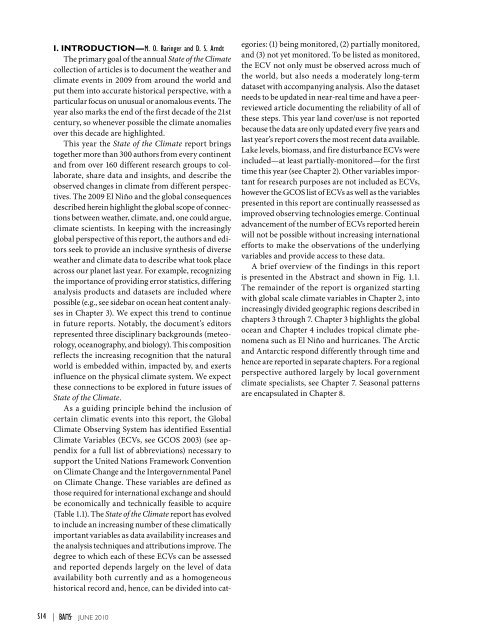Create successful ePaper yourself
Turn your PDF publications into a flip-book with our unique Google optimized e-Paper software.
I. <strong>IN</strong>TRODUCTION—M. O. Baringer and D. S. ArndtThe primary goal of the annual State of the Climatecollection of articles is to document the weather andclimate events in <strong>2009</strong> from around the world andput them into accurate historical perspective, with aparticular focus on unusual or anomalous events. Theyear also marks the end of the first decade of the 21stcentury, so whenever possible the climate anomaliesover this decade are highlighted.This year the State of the Climate report bringstogether more than 300 authors from every continentand from over 160 different research groups to collaborate,share data and insights, and describe theobserved changes in climate from different perspectives.The <strong>2009</strong> El Niño and the global consequencesdescribed herein highlight the global scope of connectionsbetween weather, climate, and, one could argue,climate scientists. In keeping with the increasinglyglobal perspective of this report, the authors and editorsseek to provide an inclusive synthesis of diverseweather and climate data to describe what took placeacross our planet last year. For example, recognizingthe importance of providing error statistics, differinganalysis products and datasets are included wherepossible (e.g., see sidebar on ocean heat content analysesin Chapter 3). We expect this trend to continuein future reports. Notably, the document’s editorsrepresented three disciplinary backgrounds (meteorology,oceanography, and biology). This compositionreflects the increasing recognition that the naturalworld is embedded within, impacted by, and exertsinfluence on the physical climate system. We expectthese connections to be explored in future issues ofState of the Climate.As a guiding principle behind the inclusion ofcertain climatic events into this report, the GlobalClimate Observing System has identified EssentialClimate Variables (ECVs, see GCOS 2003) (see appendixfor a full list of abbreviations) necessary tosupport the United Nations Framework Conventionon Climate Change and the Intergovernmental Panelon Climate Change. These variables are defined asthose required for international exchange and shouldbe economically and technically feasible to acquire(Table 1.1). The State of the Climate report has evolvedto include an increasing number of these climaticallyimportant variables as data availability increases andthe analysis techniques and attributions improve. Thedegree to which each of these ECVs can be assessedand reported depends largely on the level of dataavailability both currently and as a homogeneoushistorical record and, hence, can be divided into categories:(1) being monitored, (2) partially monitored,and (3) not yet monitored. To be listed as monitored,the ECV not only must be observed across much ofthe world, but also needs a moderately long-termdataset with accompanying analysis. Also the datasetneeds to be updated in near-real time and have a peerreviewedarticle documenting the reliability of all ofthese steps. This year land cover/use is not reportedbecause the data are only updated every five years andlast year’s report covers the most recent data available.Lake levels, biomass, and fire disturbance ECVs wereincluded—at least partially-monitored—for the firsttime this year (see Chapter 2). Other variables importantfor research purposes are not included as ECVs,however the GCOS list of ECVs as well as the variablespresented in this report are continually reassessed asimproved observing technologies emerge. Continualadvancement of the number of ECVs reported hereinwill not be possible without increasing internationalefforts to make the observations of the underlyingvariables and provide access to these data.A brief overview of the findings in this reportis presented in the Abstract and shown in Fig. 1.1.The remainder of the report is organized startingwith global scale climate variables in Chapter 2, intoincreasingly divided geographic regions described inchapters 3 through 7. Chapter 3 highlights the globalocean and Chapter 4 includes tropical climate phenomenasuch as El Niño and hurricanes. The Arcticand Antarctic respond differently through time andhence are reported in separate chapters. For a regionalperspective authored largely by local governmentclimate specialists, see Chapter 7. Seasonal patternsare encapsulated in Chapter 8.S14 | juNE 2010
















